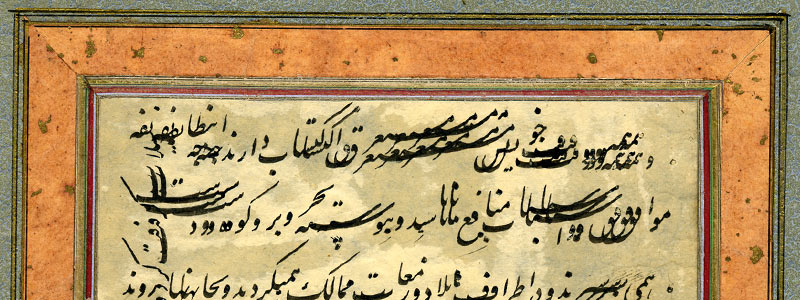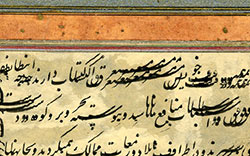Mohammad Hosayn Sayfi Qazvini, better known as ‘Emād al-Kottāb ("Buttress of Scribes"), was born in 1861 CE. He was named after his father, who was also named Mohammad, but he received his family name from his mother, who was related to an elite family who traced their lineage back to the Safavids known as the Sādāt Sayfi-ye Qazvin. As a young man he travelled to many cities and tried his hand at various jobs, but around the age of 24 he settled in Tehran and worked to earn a living by teaching and accepting other temporary jobs. In addition to Nasta‘liq, Mohammad Hosayn had mastery over almost every script, especially Naskh and Shakastah Nasta‘liq. He also possessed a natural gift for composing poetic verses.
One of the most important events of his life was his participation in a secret militant organization known as the Komīta-ye mojāzāt (the Penal Committee). During his membership in the organization, ‘Emād al-Kottāb began to write and distribute clandestine communiqués. After the group was exposed, ‘Emād al-Kottāb was arrested and condemned to five years in jail. During these years he produced many works of Siyāh Mashq, most of which consisted of the murmurings of his mind, with calligraphy functioning as a way to record his incidental thoughts to himself. These have been published in Tehran in recent years.
‘Emād al-Kottāb, in addition to being one of the teachers of Mozaffar-al-Din Shāh (r. 1896-1907) and Ahmad Shāh Qājār (r. 1909-1925) and a number of princes, also had many other pupils such as ‘Ali Manzuri , Ebrāhim Buzari, ‘Ali Akbar Kāveh and Hasan Zayn-e Khat. Many contemporary Iranian masters of calligraphy were students of individuals trained by ‘Emād al-Kottāb, so it could be said that we are only a generation or two away from the original teachings of this exceptional calligrapher.
‘Emād al-Kottāb produced many of works of calligraphy, among them Amir Bahādori’s Shahnamah of Ferdowsi, Divān Nāser Khosrow, and the Qur’an (written in the Naskh script). His greatest artistic achievement that has had the greatest influence, however, was his design and publication of Rasm al-Mashq (“The Standards and Form of Siyāh Mashq”), which is the product of his many years striving to educate people in modern calligraphy.
Mohammad Hosayn died in 1936 CE and was buried at the Shrine of Abdo’llāh in the vicinity of Rayy (Tehran).




